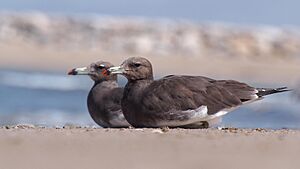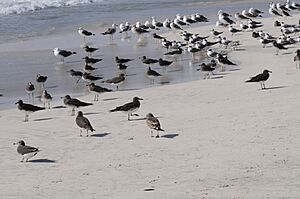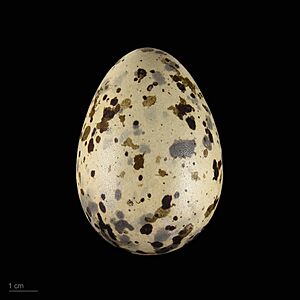Sooty gull facts for kids
Quick facts for kids Sooty gull |
|
|---|---|
 |
|
| Sooty gulls in Oman | |
| Conservation status | |
| Scientific classification | |
| Genus: |
Ichthyaetus
|
| Species: |
hemprichii
|
| Synonyms | |
|
|
The sooty gull (Ichthyaetus hemprichii) is a type of gull that lives near the sea. It's also known as the Aden gull or Hemprich's gull. You can find these birds in many countries, including Bahrain, Djibouti, Egypt, Eritrea, India, Iran, Israel, Jordan, Kenya, Lebanon, Maldives, Mozambique, Oman, Pakistan, Palestine, Qatar, Saudi Arabia, Somalia, Sri Lanka, Sudan, Tanzania, United Arab Emirates, and Yemen.
Like many gulls, it used to be called a Larus gull. The sooty gull got its name from a German scientist named Wilhelm Hemprich. He sadly passed away in 1825 while exploring Egypt and the Middle East.
Contents
Where Do Sooty Gulls Live?
The sooty gull naturally lives around the Red Sea, the Gulf of Aden, the Gulf of Oman, and the Persian Gulf. Its home range stretches all the way east to Pakistan. You can also find it along the east coast of Africa, as far south as Tanzania and Mozambique. Sometimes, a sooty gull might wander to places like India, Sri Lanka, the Maldives, Jordan, Lebanon, Israel, and Bahrain.
These gulls are mostly found near the coast. They usually stay within about 10 kilometers (6 miles) of the shore, especially near coral reefs. However, they have sometimes been seen as far as 140 kilometers (87 miles) from land. Sooty gulls love hanging out in ports and harbors, along the coast, on islands close to shore, and in the areas where the tide goes in and out. They rarely go inland or visit places with fresh water. Many sooty gulls travel south after they have their babies, but those living around the Red Sea tend to stay in one place.
What Do Sooty Gulls Eat?
The sooty gull is a hunter and a scavenger. This means it hunts for its own food and also eats things that others have left behind. They often eat fish that people have thrown away or parts of fish. They also catch small fish themselves. Sooty gulls enjoy eating prawns, baby turtles that have just hatched, and even the eggs and chicks of other sea birds.
Nesting and Raising Chicks
Sooty gulls have their babies during the summer months. They usually build their nests in small groups, called colonies. They prefer to nest on coral islands close to the shore. These islands are often protected by reefs and have rocks, sand, and a few plants.
Sometimes, a sooty gull pair might nest all by themselves, especially in Africa. Other times, their nests are spread out among the nests of other sea birds that also live in colonies. A sooty gull's nest can be as simple as a bare scratch in the coral, out in the open. Or, it might be hidden under a piece of coral that hangs over, or tucked away under a low-growing mangrove tree or a seepweed bush.
Are Sooty Gulls Safe?
The IUCN (International Union for Conservation of Nature) says the sooty gull is a species of "Least Concern". This is good news! It means that the bird lives in a very large area, and there are many sooty gulls in total. Even though the number of sooty gulls might be slowly going down, it's not decreasing fast enough to be worried about them becoming endangered.
The main things that could harm sooty gulls are:
- Oil exploration in places where they usually have their babies.
- Land being changed or built on, which takes away their natural homes.
- The chance of oil spills, which can be very dangerous for sea birds.




